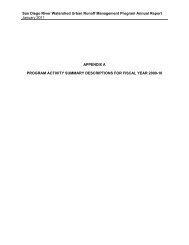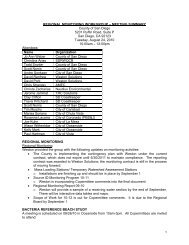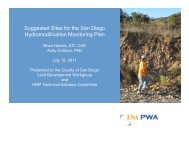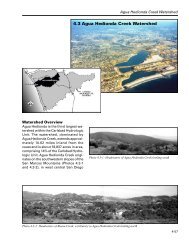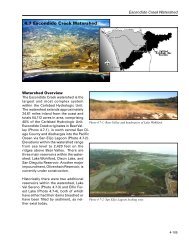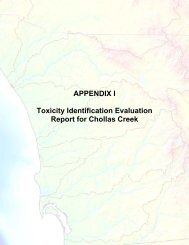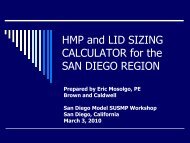APPENDIX I Toxicity Identification Evaluation Reports for Chollas ...
APPENDIX I Toxicity Identification Evaluation Reports for Chollas ...
APPENDIX I Toxicity Identification Evaluation Reports for Chollas ...
Create successful ePaper yourself
Turn your PDF publications into a flip-book with our unique Google optimized e-Paper software.
<strong>Toxicity</strong> <strong>Identification</strong> <strong>Evaluation</strong> of Sweetwater<br />
River Stormwater Using Selenastrum<br />
capricornutum August 2006<br />
5. DISCUSSION<br />
Results of this TIE indicate that one or more cations that comprise the total dissolved solids<br />
(TDS) found in stormwater samples from Sweetwater River may be responsible <strong>for</strong> the reduced<br />
growth of S. capricornutum. First, the results of the 8 mg/L EDTA test allowed <strong>for</strong> the increased<br />
growth of S. capricornutum or demonstrated that toxicity was reduced through the addition of<br />
EDTA to the 100% stormwater sample. This indicates that the causative agent of toxicity was a<br />
cation, such as a free metal ion (e.g., cadmium, mercury, lead), a dissolved inorganic salt (e.g.,<br />
sodium, calcium, magnesium), or a cationic organic compound such as a cationic surfactant,<br />
because EDTA is a chelating agent that is well known to bind inorganic and organic cationic<br />
chemicals (USEPA 1991).<br />
In addition to TIE tests, chemical analyses of Sweetwater stormwater samples indicate that<br />
cations comprising the TDS may be the causative agent(s) of toxicity. Concentrations of TDS<br />
measured in the undiluted stormwater sample were 2640 mg/L (see results in complete<br />
stormwater report), a concentration that exceeds the water quality objectives <strong>for</strong> this measure,<br />
or 1500 mg/L, in the lower Sweetwater River (RWQCB 1994). In contrast, no organophosphate<br />
pesticides were detected in stormwater samples and the only metals detected were arsenic,<br />
nickel, and zinc, all of which were found at low concentrations, or concentrations far below water<br />
quality objectives.<br />
TIE test results also indicate that the causative agents of toxicity in the Sweetwater River<br />
stormwater samples did not share similar physicochemical properties to those of many other<br />
classes of chemicals. The lack of toxicity reduction in the SPE and PBO tests indicates that the<br />
causative agent was likely not a non-polar organic, or a common-use pesticide (e.g. pyrethroid<br />
or organophosphate), respectively.<br />
Statistical analyses of TIE results also provide some evidence that the causative agent could be<br />
a ion imbalance; growth was diminished in the undiluted 100% stormwater sample, relative to all<br />
treatments while growth was elevated in the 50% and 75% stormwater sample relative to the<br />
dilution water (0% stormwater) sample. This result indicates that the causative agent was toxic<br />
in the undiluted stormwater sample but significantly less toxic in the diluted stormwater samples.<br />
In contrast, in the dilution water control, the lack of ions may have led to diminished growth<br />
relative to the diluted stormwater samples. This result is not surprising because others have<br />
shown that elevated growth in TDS-enriched natural waters as compared to TDS-poor synthetic<br />
mediums (LeBlond and Duffy 2001).<br />
It is well known that elevated concentrations of ions comprising the TDS, or an imbalance of the<br />
ions comprising the TDS may be toxic to aquatic organisms; however, the concentration of TDS<br />
that causes toxicity is highly dependent on the species and types of ions comprising the TDS.<br />
While most species are tolerant of concentrations of TDS that exceed 1000 mg/L, some<br />
spawning or larval fishes are highly sensitive to TDS. Concentrations of 350 mg/L TDS reduced<br />
spawning of striped bass (Morone saxatilis) in the San Francisco Bay-Delta (Kaiser Engineers,<br />
1969). In contrast the LC 50 <strong>for</strong> TDS <strong>for</strong> fathead minnows (Pimphales promelas) has been shown<br />
to range from 2,000 mg/L to 15,000 mg/L in natural waters, depending in part on the types of<br />
ions comprising the TDS (Mount et al. 1997). To the best of our knowledge, little is known about<br />
the effects of TDS on S. capricornutum.<br />
Weston Solutions, Inc. 11







